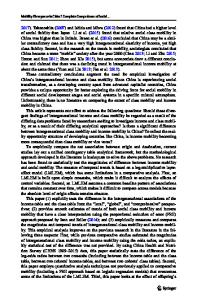The impact of taxes on income mobility
- PDF / 5,700,968 Bytes
- 61 Pages / 439.37 x 666.142 pts Page_size
- 60 Downloads / 340 Views
The impact of taxes on income mobility Mario Alloza1 Accepted: 3 September 2020 © Springer Science+Business Media, LLC, part of Springer Nature 2020
Abstract This paper investigates how taxes affect relative mobility in the income distribution in the USA. Panel data for continuously married households drawn from the PSID between 1967 and 1996 are employed to analyse the relationship between marginal tax rates and the probability of staying in the same income decile. Exogenous variation in marginal tax rates is identified by using counterfactual rates based on legislated changes in the tax schedule. I find that higher marginal tax rates reduce income mobility. An increase in 1% point in marginal tax rates causes a decline of around 0.5% points in the probability of changing to a different income quintile. Tax reforms that reduce marginal rates by 7% points are estimated to account for around a tenth of the average movements in the income distribution in a year. Additional results suggest that the effect of taxes on income mobility differs according to the level of human capital and that it is particularly significant when considering mobility at the bottom of the distribution. Keywords Income mobility · Inequality · Marginal tax rate JEL classification: E24 · E62 · D31 · D63 · H24 · H31
1 Introduction The last four decades have witnessed a sustained increase in income and wealth inequality in the USA, particularly at the top end of the distribution.1 This phenomenon has received substantial attention in academic research,2 policy debates 1 See Piketty and Saez (2003) for long-run trends in income inequality and Saez and Zucman (2016) or Quadrini and Ríos-Rull (2015) for the case of wealth. 2
Piketty (2014) provides extensive evidence of income and wealth inequality around the world while Stiglitz (2012) highlights its consequences: “the impact of inequality on societies is now increasingly well understood -higher crime, health problems, and mental illness, lower educational achievements, social cohesion and life expectancy” (inside cover). * Mario Alloza [email protected] 1
Bank of Spain and CfM, Banco de España, Calle Alcalá 48, 28014 Madrid, Spain
13
Vol.:(0123456789)
M. Alloza
as mentioned in President Obama’s Economic Report (see Council of Economic Advisers (2015)), and popular opinion (e.g. protest movements such as Occupy Wall Street). As noted in Arrow and Intriligator (2015), inequality is a highly relevant normative issue, since society perceives an unequal distribution of income as an unjust outcome of market economies. However, there are other features of the income distribution beyond inequality that have welfare implications for the society and are relevant from a policy point of view. Overlooking some of these aspects may yield an incomplete or inaccurate picture of the effects of policies that address economic disparities. This paper looks at the impact of fiscal policy on another aspect of the income distribution other than inequality. Particularly, I investigate the relationship be
Data Loading...











